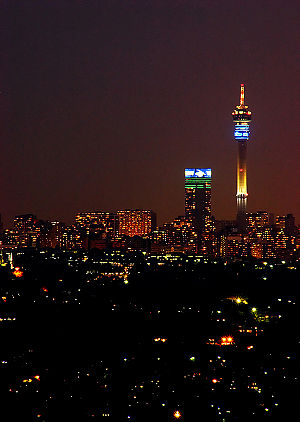Hillbrow | |
|---|---|
 Hillbrow and the Hillbrow Tower | |
| Coordinates: 26°11′20″S 28°2′56″E / 26.18889°S 28.04889°E | |
| Country | South Africa |
| Province | Gauteng |
| Municipality | City of Gauteng |
| Established | 1894 |
| Area | |
• Total | 1.08 km2 (0.42 sq mi) |
| Population (2011)[1] | |
• Total | 74,131 |
| • Density | 69,000/km2 (180,000/sq mi) |
| Racial makeup (2011) | |
| • Black African | 98.3% |
| • Coloured | 0.9% |
| • Indian/Asian | 0.3% |
| • White | 0.4% |
| • Other | 0.2% |
| First languages (2011) | |
| • Zulu | 36.7% |
| • Southern Ndebele | 16.1% |
| • English | 9.7% |
| • Northern Sotho | 7.1% |
| • Other | 30.4% |
| Time zone | UTC+2 (SAST) |
| Postal code (street) | 2001 |
| PO box | 2038 |
| Area code | 010 |

Hillbrow ( /ˈhɪlbroʊ/) is an inner city residential neighbourhood of Johannesburg, Gauteng Province, South Africa. It is known for its high levels of population density, unemployment, poverty, prostitution[2] and crime.
It had a large and active Jewish community for much of the twentieth century and housed several Orthodox synagogues such as the Great Synagogue and Poswohl Synagogue. Temple Israel, the oldest Reform synagogue in the country, continues to hold services. In the 1970s it was an Apartheid-designated "whites only" area under the Group Areas Act, but later became a "grey area", where people of different ethnicities lived together. It acquired a cosmopolitan and politically progressive feel, and was one of the first identifiable gay and lesbian areas in urban South Africa. However, due to the mass growth of the population of poor and unemployed people after the end of Apartheid, crime soared and the streets became strewn with rubbish.[3] This, together with lack of investment and fear led to an exodus of middle-class residents in the 1980s and the decay of major buildings, leaving in its wake an urban slum by the 1990s.[4]
Today, the majority of the residents are incoming migrants from the townships, rural areas and the rest of Africa, many living in abject poverty. An urban regeneration programme is underway. There are street markets, mainly used by local residents, and the Johannesburg Art Gallery contains work by major local artists including William Kentridge.
- ^ a b c d "Sub Place Hillbrow". Census 2011.
- ^ Richter, Marlise (January 2008). "Erotic Labour in Hillbrow: Sex work, Johannesburg's' Den of Iniquity'and HIV/AIDS". HIV and the World of Work Conference. Retrieved 30 January 2019.
- ^ Conway, Daniel (December 2009). "Queering Apartheid: The National Party's 1987 'Gay Rights' Election Campaign in Hillbrow". Journal of Southern African Studies. 35 (4): 849–863. doi:10.1080/03057070903313210. S2CID 144525158.
- ^ Morris, Alan (1999). Bleakness and Light: Inner-City Transition in Hillbrow, Johannesburg. Johannesburg: University of the Witwatersrand Press.

